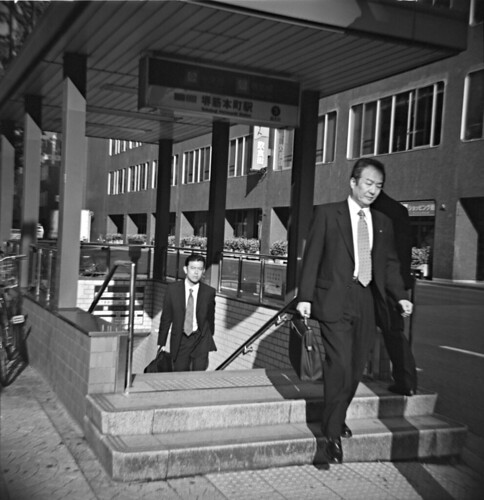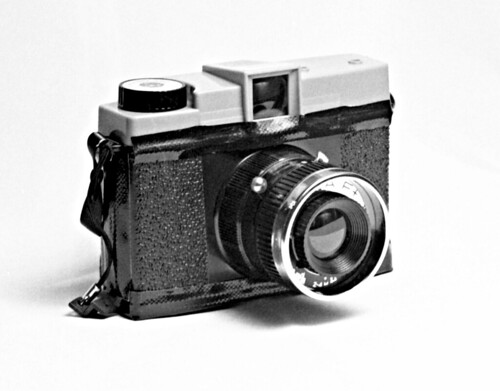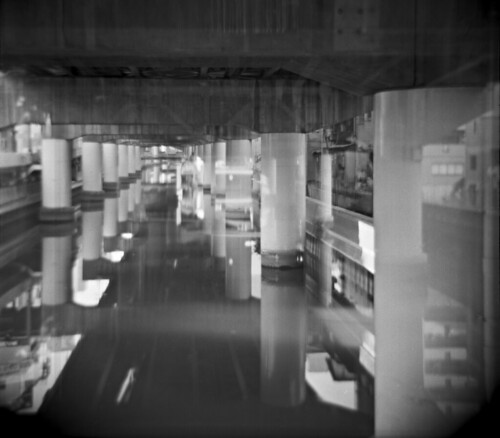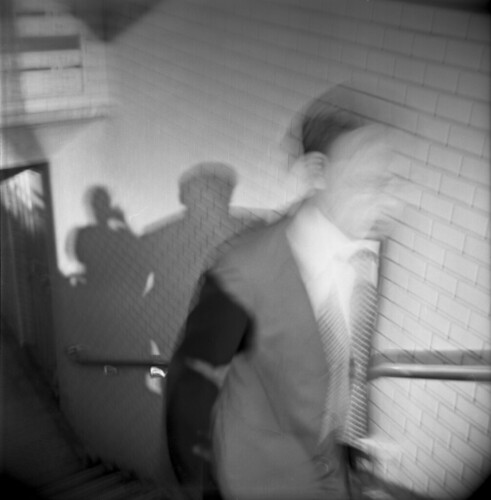The original Diana was a silly cheap plastic toy camera made in the 1960's by a Chinese plastics company and sold as a promotional item ("Apply for our store loyalty card and get a camera FREE!!") or sold in discount stores as a childrens toy. It was discontinued after a few years, but the camera found a following as an "anti-camera" of sorts; some people embraced its many faults and started photographing with it for real. As the years passed it became something of a cult item, and finally the Lomographic Society, makers of current Soviet-designed Lomo cameras, decided to make a slightly updated new version of it. They kept the functional parts like the lens and body mechanics, but added touches like a pinhole aperture and the ability to shoot in different formats.
Now, given it's history it's of course not exactly the cream of the crop as far as quality goes. It is a cheap, flimsy plastic camera; so light that you wonder if they forgot to put any actual mechanics inside it. That's not to say it's not good value - I took a quick look at medium-format gear for sale on the net, and the Diana+ kit with camera, instruction manual and a very nicely produced book with the camera history, interviews and short stories interleaved with lots of example images costs exactly the same as a spare lens cap for a Rolleiflex TLR. Don't expect TLR quality in other words.
Comparing the Diana to a "real" camera would be unfair. This is not a serious tool for carefully planned, well-metered, deliberately executed shots. Instead, it's meant to be used for spontaneous, unplanned, uncomposed snapshots; the kind where, when you get to see the images, you have no idea what's going to be there and how it'd turned out. You can see lots and lots of examples here for instance. Exactly the kind of shots, in fact, that I was getting with my old Handy Box box camera, another old, extremely simple design. Let's compare them.
The Camera
The Diana is, as I said above, very flimsy. It's almost all plastic, including the lens, with a few metal bits only where plastic just won't do. The Handy Box, by contrast, is all metal, with a glass lens. The difference, when you hold them, is profound - if you drop the Diana you'll worry that the camera will break; if you drop the Handy Box your only worry is the ugly impact marks on the floor. I would not expect the Diana to be long for this world when stuffed into my backpack. As the camera is not actually guaranteed to be light-proof (violating the perhaps most basic definition of a camera as "a lightproof box with a controllable opening"), you need to tape up the body seams and that does give it some additional stability.
Both cameras have very simple viewfinders that show a view only vaguely related to what you'll get in your picture. The Diana viewfinder is pretty inaccurate of course but overall not bad at all. It's large and bright - well, it is basically a hole through the camera - and a lot easier to use than the Handy Box viewfinder. That's not a terribly high bar to crawl over of course; with the Handy Box I ended up ignoring the viewfinder altogether.

Office workers on their morning commute. Give the camera a medium-distance subject and contrasty light and the results aren't bad.
While the Handy Box controls are basically nonexistent, the Diana does provide you with both variable focus and aperture control. The focus is highly approximate of course (close, medium and far, more or less), and the aperture control is limited to f/11, f/16 and f/22 and an extra pinhole aperture (f/150 or so). Nevertheless, a dramatic improvement in the amount of control you get. Like the Handy Box you have only two shutter modes: quick (about 1/60) and bulb where you open and close manually.

Bike speeding past. 1/60 is not enough to capture fast movements - or plenty, depending on what effect you want.
In Use
Loading the film is a pain, and the clearest example of the Lomographic Society designers going a bit too far in copying the original camera. Like most rollfilm cameras, you load the Diana by putting a roll of film in one compartment, pulling the film across to the empty uptake spool in the other compartment, wind the film a bit until it catches properly, then you close the camera and wind to the first frame. Easy. Except, it's not very easy with the Diana.
The problem is that the film spool and the empty spool need to, well, spool the film when loading it. The spools need to rotate in place, so they need a tab or knob at either end as an axle for the spool. But with the Diana, the bottom tabs are part of the cover, not part of the film spool compartments, so when you first start loading the film you can't wind the film in the normal manner; the spools just jump around. What you need to do is remove the empty spool, hook the film end into the uptake spool and wind it on for a few turns while out of the camera, and only then carefully place both spools in the body and line them up so you hopefully can close the cover properly. It's a hassle, and worse, an unnecessary hassle. This has no impact on the image quality or handling, so keeping this design flaw just because the original had it makes no sense.
As the camera is so light, it's easy to take along, and it's easy to use one-handed if you want (the shutter in on the side of the lens barrel, making it really easy). On the other hand, as it is so light it doesn't stand securely if you put it down; that makes it a bit more difficult to take long exposure shots. The Handy Box is a lot more stable - and not just because it's metal, but also because it's a box. It has a large, square footprint that will stay a lot more stable than the narrow bottom of the Diana.

My morning commute. The camera is light, to it was easy to press it up against the ceiling and hold the shutter open for about a second.
The Images
Well, this is where we discover that a plastic one-element lens mounted in a flexing body with wide tolerances does indeed not produce much of an image. Overall, I'd say the Diana and the Handy Box are just about comparable. Vignetting is pronounced, overall contrast is low and sharpness is not something that naturally comes to either of these cameras. True, the Handy Box is a higher-quality item with a glass lens and rigid body; on the other hand, the Diana design is about 20 years younger and has presumably incorporated some of the advances during those years.
In the end, for a play camera which would I choose - which will I choose to take out from time to time? As of now I still don't know. On one hand I do appreciate the variable aperture of the Diana, and the ability to shoot pinhole images is a great selling point all by itself. When people see it they seem to refuse to believe it's a real camera so shooting people is very easy. But the very breakable body with protruding lens, the light leaks and the difficulty of loading it doesn't really inspire the confidence I need to really rely on it. And while focusing and variable aperture are great tools, operating them does distract you from taking the image.
On the other, the Handy Box is all but indestructible and so silly easy to use (from loading the film to shooting) that there really is nothing to it - you decide whether to take an image and that's it. Yoda said it best: "Take. Or not take. There is no focusdistanceDOF





No comments:
Post a Comment
Comment away. Be nice. I no longer allow anonymous posts to reduce the spam.